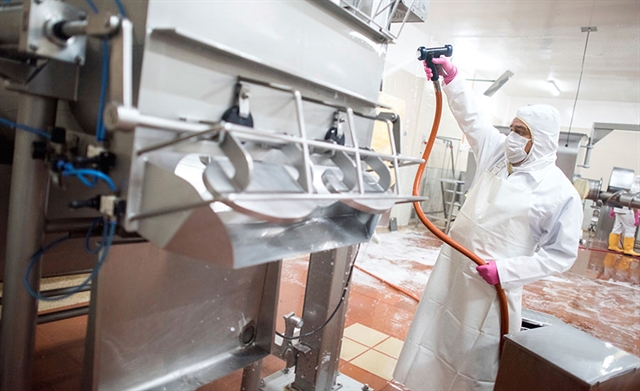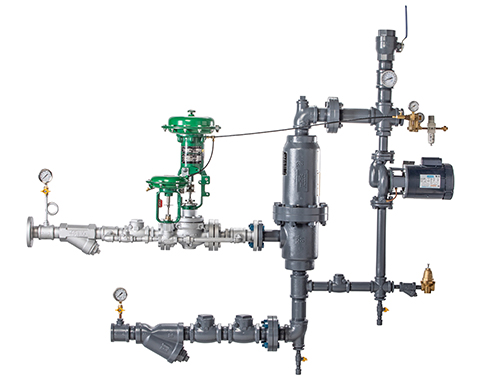Just as there are numerous industrial applications for water heating, so too are there many challenges — maximizing energy efficiency, minimizing maintenance costs and many others. Nowhere is this more apparent than in the food and beverage industry, where adherence to strict regulations around the use of hot water ensures the safety of personnel and the quality of the product itself.
The design of hose stations used for plant sanitation offers an illustration of the safety challenges. Individual mixing tees, which provide point‐of‐use access to steam combined with water, are a common feature for washdowns in food and beverage processing plants. These units offer the instant responsiveness of steam injection heaters, but they also carry a steep price in terms of safety concerns.
One reason is that operators can increase the temperature of hot water released from the tee in the interest of speeding a sanitation job. This tendency follows the common misconception that a higher temperature equals a cleaner surface, when in fact it both wastes energy and unleashes the potential for burns and scalding. Adding to that danger is the fact that the pressure‐sensitive internal valve built into the tee as a safety measure can stick, due to hard water scaling built up over time.
Sanitation in the food and beverage industry, moreover, must conform to regulations designed to prevent food contamination. If critical temperatures are not met, USDA inspectors can shut down plants, or portions of them — resulting in lost production time, and the potential for product recalls. While small fixes may address these challenges in the short term, the most effective solutions are built into the design of the heating system itself. A centralized heating system, for instance, moves steam/water mixing into a remote location and away from process floor point‐of‐use hose stations. Temperature adjustability is no longer required at each station and the temperature control system can be passcode‐protected to restrict equipment control accessibility, while temperature overrides can be deployed to catch upset conditions.
Systems built around commonly deployed indirect heating methods, such as shell‐and‐tube and plate‐and‐frame heat exchangers, present the issue of poor temperature control. Overshooting to ensure that critical temperatures are met is a common strategy to address this challenge — albeit a highly inefficient one. The same applies to the practice of making ongoing adjustments to set point temperatures as a way of staying on top of flow rate changes.
 Figure 1. The challenges of industrial water heating applications are particularly relevant to the food and beverage industry.
Figure 1. The challenges of industrial water heating applications are particularly relevant to the food and beverage industry.
Indirect systems also have an inherent capacity limit, which impacts the volume of hot water available for various processes. This can cause line speed slow‐downs during production, and full stops during high‐demand periods such as third‐shift cleaning and washdown.
The challenge of operating efficiently is further exacerbated by hard water scaling, which is caused by hard mineral deposits falling out of the solution as water temperatures increase. Scaling is counterproductive, as it insulates the water from heat transfer, while also causing system pumps to work harder to circulate water.
The presence of scaling is a challenge for all types of heat exchange systems, but removing it is particularly cumbersome within the intricate design of the tube bundles or plates used in common indirect heat exchange designs. Direct Steam Injection (DSI) Systems are easier to keep clean with routine maintenance; because DSI heat transfer surfaces are minimal, and they also offer less opportunity for scaling buildup.
In addition, the design of DSI Systems enables tight temperature control, instantaneous and rapid responsiveness to flow changes and consistent capacity levels — resulting in greater efficiency and lower maintenance expenditures overall.
Despite the advantages of a DSI system, not all units are created equal.
An important design consideration is the management of condensation, which is naturally produced as steam is mixed with water. Rapid changes can cause this process to become rough and inconsistent, producing bubbles of uncondensed steam. As they encounter cold pipe walls, the bubbles collapse; this results in vibration and noise, also known as steam hammer. The problem is more than a mere annoyance, as it can create damaging cavitation to tank walls and piping — which, in turn, increases the likelihood of leakage and, ultimately, equipment failure.
One strategy often suggested for mitigating steam hammer is to keep liquid flow changes gradual, which allows the system’s temperature control loop time to respond. This is not necessarily practical in the real world, however. Pick Heaters developed its variable flow heater to take a more proactive approach: It responds automatically with precise temperature control suitable to a wide range of changes in both pressure and flow. The system also compensates for low‐flow conditions, intermittent use and idle periods, each of which can impact responsiveness.
Another design strategy to work around the issue of steam hammer is using sonic velocity to ensure rapid mixing and condensation. However, this approach requires forceful condensation of steam into the water stream, which presents the very condition it attempts to address. It also requires downstream piping to accommodate high flow velocities of both water and steam, increasing noise and adding to system cost. A variable flow system, by contrast, functions with low velocity and low noise, harnessing energy in the heater body and eliminating the need for straight‐run downstream piping.
All systems go
Piecemeal solutions to the challenges of industrial water heating applications may be suitable in the short term, but they do not address the underlying issues impacting plant safety, efficiency and costs. A more forward‐thinking option is system deployment that addresses the plant as a whole.
DSI addresses many of these issues at the root. The Pick Heaters Variable Flow System offers a solution: It solves not only readily obvious issues such as steam hammer and poor temperature control, but also facilitates maintenance and sanitation tasks that directly impact the bottom line. It is designed to serve as a centralized heating system that can be isolated from operators and use points, while also accommodating the full range of flow rates needed throughout the plant.
Of course, the food and beverage industry is not unique in its need for comprehensive water heating solutions that maximize efficiency. Pick Heaters systems are also deployed in the chemical, pharmaceutical and energy industries for their precise and accurate temperature control; in the pulp and paper industry for their low‐velocity, low‐noise and low‐maintenance designs; and in a handful of other industries for a wide range of specialty applications.
To learn more about the company’s unique DSI approach, contact Pick Heaters.

Figure 2. Variable Flow DSI system.